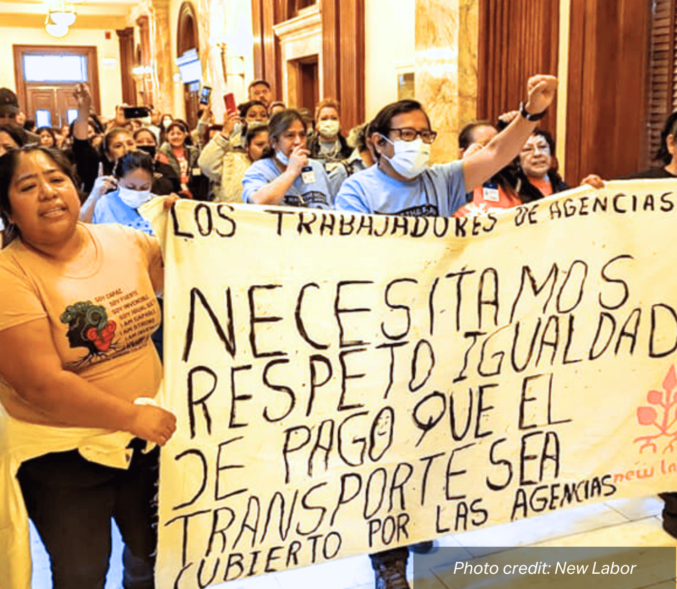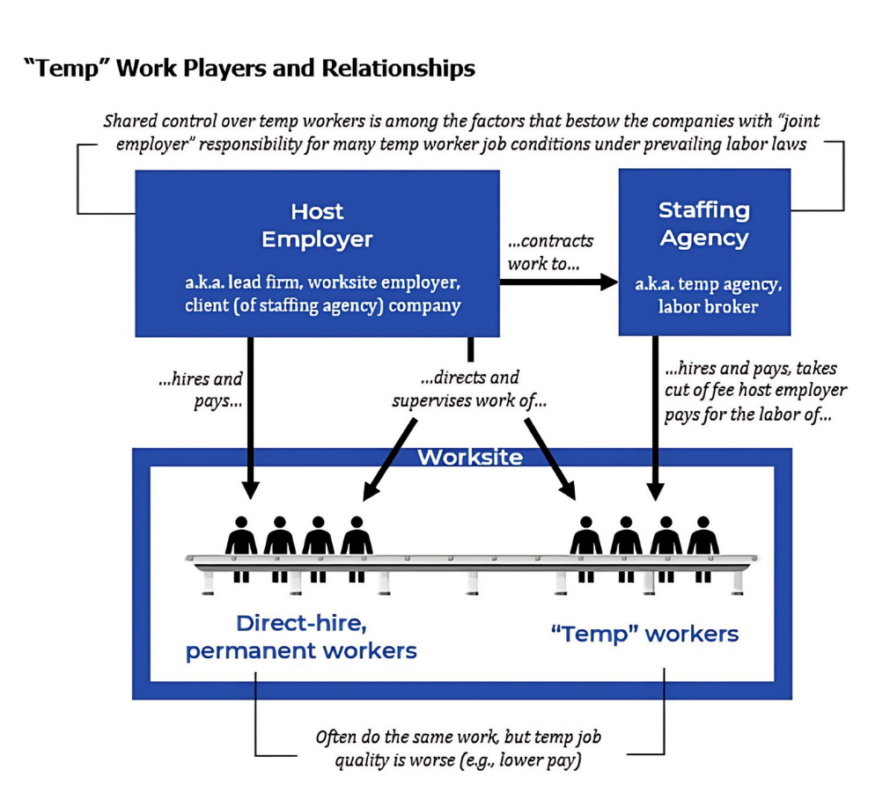Temp Workers Demand Good Jobs
Temporary workers often perform the same jobs as permanent employees, but for less pay, few benefits, and little chance of being hired. They demand better.

What Is Temp Work?
Many U.S. companies subcontract work to temporary help and staffing agencies to shed employer liability and labor costs. Job quality suffers.
Temporary workers often perform the same jobs as their directly hired counterparts, but for less pay, fewer benefits, and with little chance of being directly hired.
But worker organizing and public policy innovation are changing that. Workers are joining together to win equal pay for equal work and more.
The Reality of Temp Work
Temporary help and staffing agency workers, known as “temp workers,” are hired as employees of temp staffing agencies and assigned to work under the direction of “host employers.”
Host employers control many working conditions but contract out responsibility to the agencies, which compete for profits by lowering their labor costs.

This means many temp workers do the same work as direct-hire employees of the host employer but for:
- less pay
- little or no training regardless of work hazards
- limited or no benefits
- no job security
Temp workers can be stuck “permatemping” without hope of advancement, because contracts between host employers and temp staffing agencies block them from transitioning into permanent, direct-hire positions.
And temp workers who raise concerns about conditions can easily be replaced, which creates challenges to organizing with each other or with employees of the host employer.
Worker Voices on Temping
All stories
As a temp, they don’t care about your safety, or us as people. Everybody is expendable because the staffing agency can always get another person to work that position.

| Transportation and Material Moving | $18.24 | $15.33 | 16.0% |
| Production | $19.19 | $15.53 | -19.1% |
| Office and Administrative Support | $19.67 | $17.52 | -10.9% |
| Construction and Extraction | $24.31 | $18.45 | -24.1% |
| Building and Grounds Cleaning and Maintenance | $16.28 | $14.76 | -9.3% |
Source: U.S. Bureau of Labor Statistics, Occupational Employment and Wage Statistics, May 2022; “Temp Workers” are employed by the Temporary Help Services industry (NAICS 56132).
Trends in Temporary Work
Over the last 40 years, the U.S. labor market has shifted from long-term jobs with employer-sponsored benefits and high unionization rates to shorter-term jobs with lower wages, fewer benefits, and more obstacles to collective worker action.
Since 2009, temp staffing jobs have grown faster than overall private sector work.
Temp staffing work has also shifted from clerical and office work to more hazardous “blue collar” industrial jobs. Temp workers may be placed in hazardous jobs without health or safety trainings and face increased risk of injury as compared to direct-hire employees in similar occupations.
With the rise of digital labor platforms, temp staffing work has also gone digital. On-demand labor apps eliminate the need for a brick-and-mortar agency that directly employs the temp workers that host employers need. They supply workers to fill shifts as independent contractors who lack bedrock employment protections.
Black and Latinx Workers Are Overrepresented in Temp Staffing Work
of temp workers are Black, while Black workers make up 12.1% of the overall workforce.
of temp workers are Latinx, although Latinx workers constitute 16.6% of all workers.
Discrimination and Occupational Segregation in Temp Work
Workers of color are overrepresented in dangerous occupations in which temp staffing work is prevalent.
Black workers are 33.0 percent of temp workers in manufacturing and warehousing jobs, but just 15.5 percent of overall manufacturing and warehousing workers.
Latinx workers are 30.9 percent of temp workers in manufacturing and warehousing job, but comprise only 23.9 percent of overall manufacturing and warehousing workers.
Source: p. 16 Temp Workers Demand Good Jobs
Studies have revealed some temp staffing agencies engaged in racially discriminatory hiring or job placement, with agencies and their clients using code words to signal their preference for or disfavor of workers of a certain race or gender. Source: p. 12 Lasting Solutions for America’s Temporary Workers
The federal Work Opportunity Tax Credit program, designed to incentivize the employment of workers who face barriers to employment, is driving formerly incarcerated workers and other targeted groups—who are disproportionately people of color—into second-tier employment at temp staffing agencies. In 2023, NELP joined with partners to call for a program overhaul. See: Re: Work Opportunity Tax Credit, Request for Comments Regarding Proposed Modifications to Procedural Guidance and Administrative Formula
